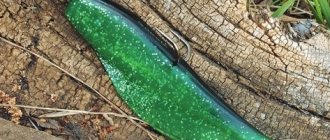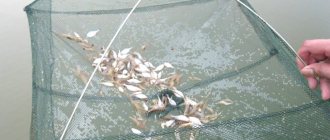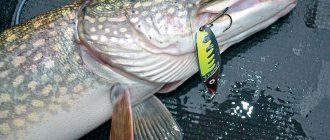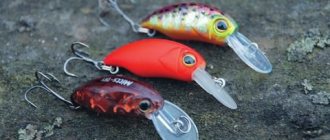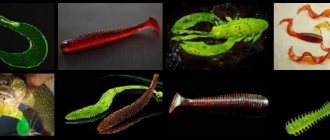Silicone bait has firmly established itself in the arsenals of spinning anglers, having proven itself to be a reliable and effective tool for catching all types of predatory fish. Recently, in addition to fans of spinning rods, fishermen who practice the float and bottom methods of catching peaceful fish have become interested in silicone. Silicone models have appeared on sale that realistically imitate movements and convey the smell of real baits that attract carp species of fish.
Using artificial bloodworms or maggots when fishing, and even rubber corn grains is already commonplace, which will not surprise most of our fishermen. The types of silicone baits are amazingly diverse, and therefore expand your fishing possibilities. Low cost, but real effectiveness of use contributes to the popularization of attachments, which is undoubtedly worth using. And how to competently understand the variety of silicone attachments, the article presented below will help the reader.
Silicone classification
To better understand the capabilities and purpose of the product, silicone baits are classified according to a number of basic qualities. Classification helps to quickly select the right bait options for certain fishing conditions, which are included in the development of strategies and tactics for the upcoming fishing. Silicone manufacturers pay important attention to such aspects of the product as its shape, size and color spectrum of the product. Based on these features of the simulators, it is quite easy to decide for what type of fishing the bait is suitable and what type of fish is the target for using silicone. In continuation of the article, we will delve into these main features in more detail, having understood which the angler can always make the right choice of the bait he needs for his planned fishing.
By shape
The most common forms of attachments currently are twisters and vibrating tails. Worms, slugs, creatures and frogs are slightly less popular, but in terms of fishing efficiency they are almost as good as the aforementioned silicone fish.
Vibrotails are completely similar to small fish. The oblong body ends in a tail, reminiscent of a horse's hoof, which has its own play with any type of wiring.
Vibrating tails and twisters
A twister is a simulator with a cylindrical main body ending in a crescent-shaped ribbon tail, sometimes significantly larger than the size of the bait body itself. Twisters are similar to a fish fry or a large insect larva. Just like vibrating tails, they have their own game.
Worms are realistic silicone replicas of dung worms, earthworms, earthworms, and crawlers. To a greater extent, these are passive baits that require animation during wiring.
Slugs are forms of bait with the body of a fish or a worm. A distinctive feature of these types is the narrowing of the tail into a thin cord-like element without any kind of thickening. Slugs do not have their own game.
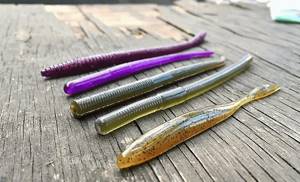
Worms and Slugs
Creatures or so-called fantasy forms in their appearance resemble small underwater inhabitants from the world of insects or crustaceans. They cannot always imitate the real essence of a real food item, being a creative invention - a fantasy from the manufacturer.
Frogs are imitations of a real amphibian, differing in subspecies into products with legs and baits in which the hind limbs are replaced with silicone fringe. Simulators with paws have the ability to play their own game. Frog bodies with silicone hairs need forced animation.
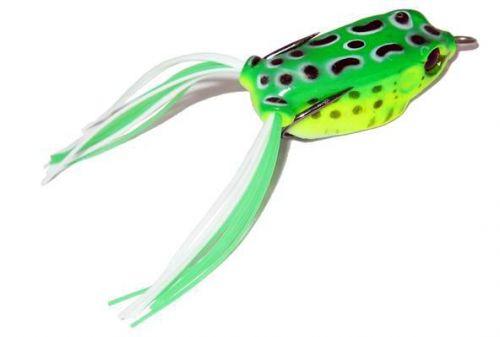
Silicone frog
Types of color solutions
Fishing with silicone baits is successful due to the varied colors of the products, which have a wide spectral range. Silicone is quite easy to color, so you can find the product on sale in natural colors and exotic colors. Thus, manipulations with color selection make it possible to fish in water with varying degrees of transparency, and also contribute to the selection of baits for hunting in different weather and time of day, despite the variability and intensity of natural light.
Based on the brightness of the color, silicone can be selected for fishing at different depths. The most common are light green or acidic colors, brown or machine oil color, carrot, bright orange or intense red color. All types of paints can be supplemented with inclusions of fluorescent elements or sparkles that increase the fish’s interest in the bait, to which a hunting object such as perch responds best.
To size
Silicone sizes are suitable for all types of spinning fishing. So, with the smallest baits you can hunt with ultralight for microjigs. Such silicones have sizes from 0.5 to 1.5 inches. Most often, baits in sizes from 2 to 9 inches are used for spinning fishing.
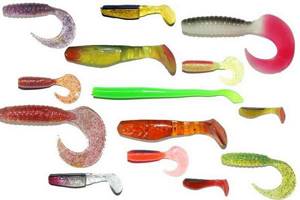
In trolling fishing, large silicone fishing baits are used, the size of which exceeds 10-12 inches. Based on the size of the simulator, a jig head and hook of suitable weight are selected for installation. At depths of up to three meters in standing waters, silicone in the size of 2–4 inches with a load weight of 6–8 grams is suitable, and in currents the load is increased to 10–12 grams. A five-inch bait under the conditions described above on a reservoir is equipped with a load of 10 grams and 12–14 grams in the current. A 7-inch simulator is accordingly supplemented with a sinker of 12 grams in calm water, and about 15 grams in currents. As a rule, the size of the hook should not be more than 1/2 the length of the bait being equipped.
Product form
Molds for silicone baits are completely different and this is not surprising because each type of fish needs to find a certain approach. What may attract pike may not be very appealing to pike perch, etc.

Today in specialized stores you can find the following forms:
- Slugs. A precisely made imitation of a small fish. When fishing, it plays a passive role;
- Vibrating tails. The bait is in the form of a fry with a flat-shaped tail, which is located perpendicular to the rest of the body;
- Frogs. Special models that are made with paws or rubber fringe. Can be either passive or active bait;
- Twisters. A bait with a cylindrical body and a soft, sickle-shaped tail;
- Creatures. Lures made in the most unusual shapes. Most often it is a copy of some river or sea creature;
- Worms. An artificial analogue of a worm that copies it very reliably. The latest models are equipped with tails, which also serve as a bait element.
Read here Corn for fishing - cooking recipes, bait and bait for different fish (75 photos)

Types of manufacturing materials
The type of material used to manufacture it has a significant impact on the performance characteristics of silicones. Despite the seemingly common group of this kind of baits, the silicone mixtures from which they are cast have different properties and chemical compositions that determine the type of finished product. Today, there are classic silicone imitations made from ordinary silicone, nozzles made from edible material saturated with attractant, made from porous silicones with positive buoyancy, as well as small products that repeat the shape of maggots or bloodworms from denser silicone masses.
All of these catchy silicone baits are used in certain fishing conditions that require specific fishing patterns and additional attractive qualities. It is especially worth noting that, regardless of the type of material used, it is not difficult to restore a bait that has undergone slight deformation using an open flame from a match or lighter. The edges of the material are melted and glued together with light compression.
Classic soft baits
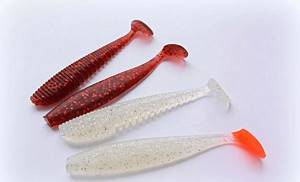
The production of soft baits, already familiar to every angler, began with the elementary melting of plastic material and the addition of dye to its composition. Silicone is melted at low temperature in a separate container and poured into pre-prepared molds. Due to its high plasticity, the resulting solution easily fills matrices for smelting creatures with graceful tentacles, thin mustaches and legs, and even more so molds for voluminous and large silicone baits, facilitating the production of cheap, effective and believable baits.
If they have the desire and opportunity, some spinning anglers independently make baits to suit their needs and requests, replenishing their arsenals with original, exotic and exclusive forms. Thus, a specimen of silicone that has lost a number of operating parameters, which often happens when attacked by powerful fish and is expressed in broken tails, can be easily processed into an attractive product and used for fishing again.
Edible silicone baits
Edible rubber is considered the most popular product among spinners hunting for predatory fish. The composition of such baits includes amino acids and all sorts of attractive attractants with odors that attract fish. For example, a pike perch, having attacked such a nozzle, senses the real smell of the victim and does not immediately spit out the simulator, as would happen in the case of ordinary silicone. This factor gives the angler additional time to hook and increases the chance of a successful bite.
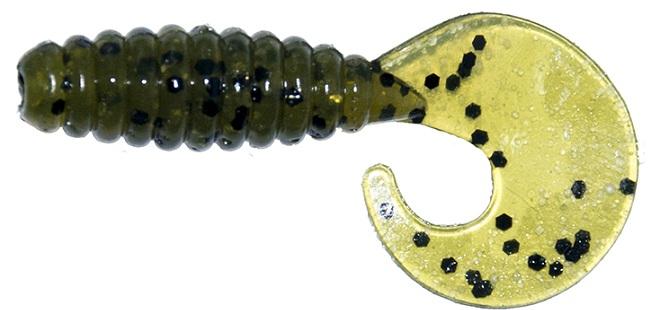
In terms of shapes and colors, this type of rubber does not differ from classic silicones. You can identify edible silicone by its specific smell, which often does not evoke positive emotions, and by a moist coating due to an oily film. The disadvantage of the nozzle is considered to be low strength and, as a result of drying, a rapid loss of attractive properties, which reduces the service life of the product.
Floating silicone
Floating silicone baits can be made from regular silicone or edible rubber. A feature of nozzles with positive buoyancy is the high porosity of the material, as a result of which the air trapped in them creates an effect that helps to stay on the water. This type of bait is suitable for fishing the upper water horizons and water areas with a high degree of overgrowth with aquatic plants. They are used for fishing both standing water bodies and water areas with moderate currents.
Silicone baits for fishing
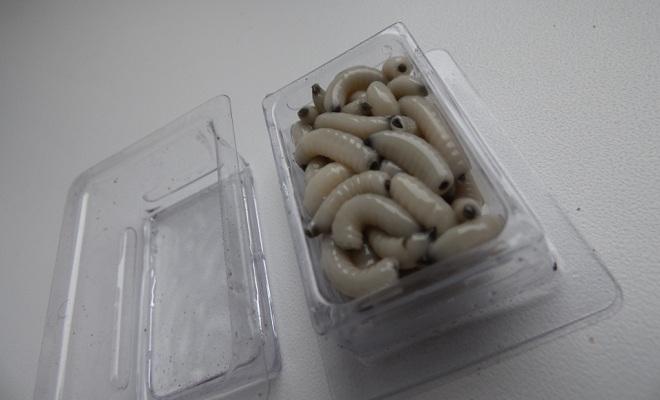
This type of rubber is in demand among lovers of catching peaceful species of fish using float and bottom equipment. In appearance, plastic silicone quite accurately imitates bloodworms, worms and maggots, both in color and size. In addition to these parameters, the baits are soaked in attractants or oils, which give the baits a taste that attracts fish. When properly stored, such a product retains its functionality for a long time, does not deteriorate and does not dry out.
An imitation bait is mounted on a hook, just like a live product, without causing absolutely any suspicion in the fish and bringing results in catches identical to the use of real animal baits.
Equipment for silicone baits
There are several types of basic methods for installing silicone baits most commonly used by anglers. Thus, installation of a twister and a vibrotail can be carried out on a single, double, triple or offset hook, selecting an accessory only according to the dimensions and size of the bait. Often the rubber is immediately mounted on a stationary jig head or in combination with a Cheburashka. Other types of silicone are most often mounted on single hooks with an extended shank.
If installing a bait on a single hook does not cause any particular difficulties, then equipping a silicone bait with a double or tee is much more difficult and for this the fisherman will need a small amount of time to master the equipment and methods of equipment. After a couple of training sessions, the method of installation is quickly memorized and with the development of a stable skill, the fisherman manipulates the equipment with silicone hooks directly on the reservoir, right while fishing.
How to choose high-quality silicone baits?
Here are some simple tips that will be useful when choosing silicone baits.
- You can evaluate the quality of the material visually. Silicone baits should not have small bubbles. Their presence indicates the poor quality of the material used in production.
- The tail and main body of a good vibrotail are one whole. We advise you not to purchase models with a glued blade.
- The softness of the tail of the vibrotail plays an important role. If it is too hard, then such a tail in conditions of slow retrieve will either not play at all, or will be extremely ineffective.
- High-quality silicone tends to stretch well. The length of artificial fish when stretched can increase by 1.5-2 times.
- Preference should be given to lures with a corrugated tail, which allows the fish to play perfectly when fishing at any pace.
Fishing with silicone
When using passive silicone baits, performance is achieved due to the method and conditions of presentation. Imitation is served in baited areas using float and bottom rigs, waiting for the fish to approach. Active baits are used in spinning fishing, using various types and styles of fishing for animation.
Important! The most common are stepped, uniform, twitching wiring and the technique of dragging the nozzle along the bottom.
The peculiar play of silicone occurs due to the actions of the fisherman with a spinning rod or reel, water resistance and the structural features of the bait. It is worth noting the fact that the size of vibrotails and twisters affects the size of the trophy; the larger the simulator, the more realistic it is to catch a larger predator.
Useful tips
- when fishing for predators at night, the main thing is to perform active amplitude movements;
- It is recommended to store silicone baits in polyethylene bags or silicone containers;
- when going fishing for pike perch, you should take with you a whole arsenal of various silicone attachments;
- active pike perch should be caught using vibrotails and twisters;
- For passive pike perch, other baits that can provoke it to attack are more preferable. First of all, these are slugs, worms and crustaceans;
- Silicone baits are much more economical to make with your own hands.
- How to store bloodworms
- Legendary spinner Mepps Syclops
- Winter mothless
- Salapinskaya porridge
The best silicone baits
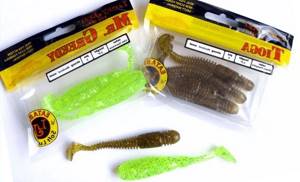
Silicone Lucky John
Focusing on purchasing quality products, preference is given to well-known global brands specializing in the production of such products.
Important! Some of the best silicone baits are produced by such companies as: Lucky John, Mann's, Relax, Reins and Crazy Fish.
Along with other companies, the products of these brands are distinguished by their low price level, a huge range of different types of silicone baits and prevalence in our domestic markets. Among the products of the represented companies, the fisherman will find high-quality edible rubber, soft silicone of various sizes and colors, fantasy shapes and imitations reminiscent of real larvae and insects used in catching predatory and peaceful fish.
Rubber storage methods
There are certain requirements for storing silicone, ignoring which leads to complete damage to the product. Products from different companies should never be stored in the same box. The specifics of production of products from different companies differ in the composition of the material, and the presence of baits together leads to their softening or melting. Also, you should not combine attachments of different colors in one cell or storage bag, as they stain each other and then lose their attractiveness.
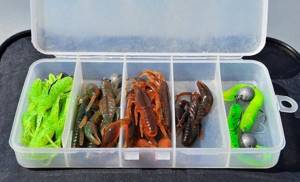
Important! They try to keep edible rubber in sealed polyethylene tubes in which they are sold in stores. Ordinary silicone retains its plasticity and does not dry out in airtight bags.
Equipping with hooks is done directly on the reservoir, during long-term storage the metal is removed from the body of the bait. In the off-season, the silicone arsenal is stored at room temperature in dark places, taking the above measures for sealing and sorting the product.
